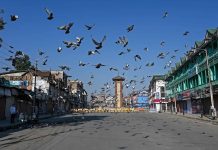TRS government is robbing the city of Nawab of its cultural and historical identity
Nikhat Fatima, Siyasat.net
While heritage sites throughout the world are being preserved through restoration works, But in Hyderabad the capital of Telangana state, heritage sites are being viewed as useless buildings and are on the radar of the TRS government that has already demolished the saifabad palace built in 1888 which served as the Secretariat till the late NT Rama Rao was the chief Minister. Other old structures demolished by this regime are the 200 year old Ek Khana Masjid of Amberpet, Victoria Zenana Hospital built in 1907, Stone building of Mint compound that was more than 100 years old and Masjid e Shafi nearly 200 years old at the secretariat complex.
As if that was not enough, the latest on the radar of Chief Minister K Chandrashekar Rao is the Osmania General Hospital built in 1919 which has been vacated and locked up in the last week of July.
The decision to close down the hospital listed in heritage sites was taken when there were incessant rains on 13th and 14th July and the rainwater flooded in some wards of the hospital putting the patients in panic.
But one of the senior doctors said, “There have been heavier rains than these earlier but the water never entered in the hospital. This time it was due to the drainage malfunctioning or rather an intentional malfunctioning.
And some reports say that the water had entered into the hospital because the course of the Nullah (near the Begum bazar Police station) was changed due to which the water flooded in the hospital. The reason for changing the direction of the watercourse is however unknown.
The government’s intention to demolish the OGH is from 2015 as CM wants to make Hyderabad a ‘global city’. But in his bid to make Hyderabad a global city, he is robbing the city of Nawab of its cultural and historical identity. His plans to demolish the structure were foiled when heritage activists protested and approached the law. But the rainwater flooding in recently seems to have given an excuse to lock up the hospital and plan to demolish it.
Heritage sites cannot be demolished just like that without permission from the committee/ body set up by the archaeology department. According to the existing laws of the nation, it is a crime to harm/ demolish sites that have been declared as heritage property.
However the CM and his team seem to have taken all this into account and have approached the court of law seeking permission to demolish the hospital and build a new one its place.
History of Osmania General Hospital
The Osmania General Hospital was earlier known as Afzalgunj Hospital and established by Salar Jung in 1866 and also served as a teaching hospital. But later when it was damaged by the floods of river Moosi, the last nizam of Hyderabad Mir Osman Ali Khan rebuilt the Afzalgunj hospital spending Rs. 20,00,000 on 25 acres. It was completed in 1919 and opened for the public from 1921 onwards. The Afzalgunj hospital came to be known as Osmania Hospital. It was designed by British architect Vincent Jerome Esch and Nawab Khan Bahadur Mirza Akbar Baig in Indo-Sarcenic style.
This was first hospital to use Hyderabad Chloroform cap which was devised by Dr. Edward Lawrie was the Principal of Hyderabad Medical School and Superintendent of Afzal Gunj Hospital for 16 years. The hospital earned worldwide reputation on account of two Hyderabad chloroform commissions.
It once had 1100 beds, 9 operation theatres, labs having high end diagnostic services, medical units and even a central oxygen facility according to senior doctor Dr. Iqbal Jaweed.
Deliberate negligence
Over the years the hospital treated and cured thousands of people but in return it craved for attention towards its deteriorating condition. The plaster from the walls kept peeling off, window hinges all broken, paan stains against the walls especially on the staircases, patches of plaster falling off from the roof and cracks in the walls developed endangering the lives of the patients making it unsafe.
The second floor was evacuated reducing the number of beds and operation theatres. But the number of patients however kept increasing as also the number of units, doctors, PGs, nurses and house surgeons. As of 2019 at least 2500 patients were treated every day and around 150 were admitted for further treatment. There were nearly 1300 beds with 1000 doctors including house surgeons and post graduate students and 190 nurses.
A nursing college and a dental hospital also came up on the 25 acres over the years along with residential quarters for the doctors and other staff.
Plans of Demolition
The very next year after formation of Telangana state and the TRS party coming in power the first CM of the newly formed state visited the hospital and found it in a neglected state and so in 2015 itself he announced that a new structure would be built in its place.
But the agitation of the heritage activists ensured that the old building remained intact. They argued that with repairs the structure can still be strong and continue to serve its purpose. Many structures listed as heritage sites that have been built much earlier to the Osmania Hospital are still intact. So can the hospital not sustain after the repairs?
Hyderabad Metropolitan Development Association (HMDA) has listed the Osmania hospital structure as a heritage building and graded it as II-B Heritage Building. Therefore it is a protected under the heritage regulations and demolishing the same will be deemed criminal unless the committee approves its demolition.
But now the hospital is locked up denying health care to the poor masses that came from far and wide. With the pandemic on and shortages of beds the decision to lock up the hospital is proving to be costly.
What the experts say?
The Indian National Trust for Art and Cultural heritage (INTACH) conducted a study to assess the Osmania hospital building whether it could be restored or not. They submitted their report to the government. They felt that with some repairs the building can become stable and safe.
Even the team of the Aga Khan Trust for Culture (AKTC) opined that the building needs to be renovated and in 2 years’ time should be good enough and be used like before. And can last another 100 years.
At one time in the year 2019, the government did seem serious to renovate the old structure and even passed a government order sanctioning 19 crores for the same.
However the recent incident in July 2020 has given a reason for the government to roll back its decision and lock up the building.
Order of the court
The High court of Telangana had asked for the site plan of the proposed world class hospital which the CM had planned to build long back. The High Court after taking on record the site plan have questioned the state as to why can’t a new building be built on the vacant land as the old hospital is built on 1.5 acres of land out of the 25 acres. The court wanted to know why the Government wants to pull down the old building when there is so much space available.
The court also felt that at a time when people needed health care due to the raging pandemic the decision of the government to construct a new building is not needed. However the matter is still pending in the court and will be up for hearing on September 24.
Many doctors and others also are of the opinion that there is a need for another building to compliment the old hospital as the number of patients is increasing and the hospital is also upgrading with more units and blood banks and so on.
And it is practical to build a new hospital on the 15 acres of land still available on the sprawling 25 acres around the Osmania Hospital without touching it. Instead the heritage site can be salvaged with some efforts thus preserving the identity, the culture and the essence of the city of Nawabs. Heritage sites are our link to the past and hope of the future.
(www.siyasat.net is Ahmedabad,Gujarat,India based website)






























